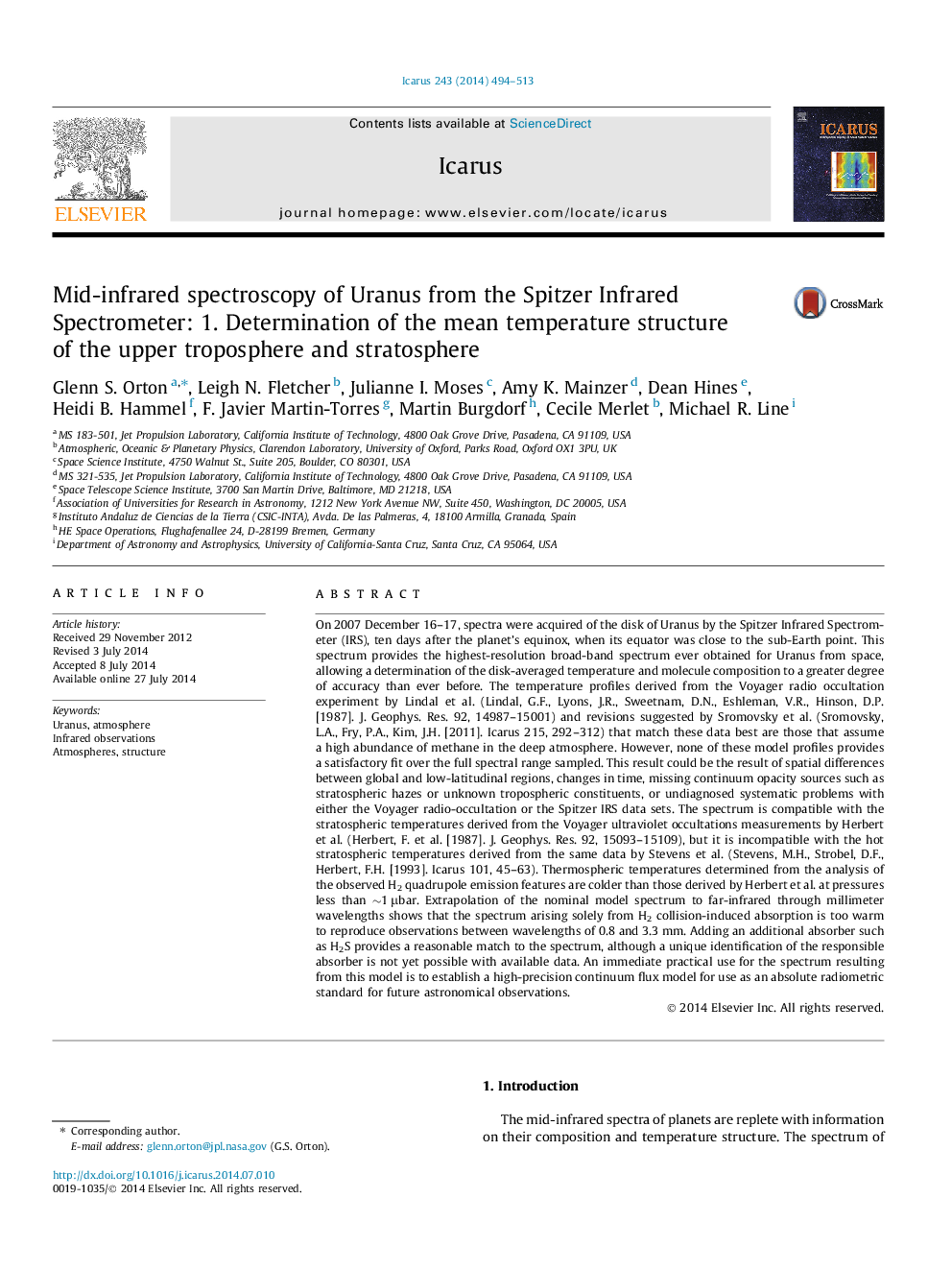| کد مقاله | کد نشریه | سال انتشار | مقاله انگلیسی | نسخه تمام متن |
|---|---|---|---|---|
| 1773113 | 1523547 | 2014 | 20 صفحه PDF | دانلود رایگان |

• We obtained the best 5–37 micron spectra of Uranus from the Spitzer IRS near its equinox.
• The spectra appear to be diagnostic of temperatures nearly as deep as the 2-bar level.
• They imply colder thermospheric temperatures than the Voyager ultraviolet results.
• The millimeter spectrum must contain an absorber, such as H2S in addition to H2 and NH3.
• The model continuum establishes a ±5% absolute radiometric standard spectrum.
On 2007 December 16–17, spectra were acquired of the disk of Uranus by the Spitzer Infrared Spectrometer (IRS), ten days after the planet’s equinox, when its equator was close to the sub-Earth point. This spectrum provides the highest-resolution broad-band spectrum ever obtained for Uranus from space, allowing a determination of the disk-averaged temperature and molecule composition to a greater degree of accuracy than ever before. The temperature profiles derived from the Voyager radio occultation experiment by Lindal et al. (Lindal, G.F., Lyons, J.R., Sweetnam, D.N., Eshleman, V.R., Hinson, D.P. [1987]. J. Geophys. Res. 92, 14987–15001) and revisions suggested by Sromovsky et al. (Sromovsky, L.A., Fry, P.A., Kim, J.H. [2011]. Icarus 215, 292–312) that match these data best are those that assume a high abundance of methane in the deep atmosphere. However, none of these model profiles provides a satisfactory fit over the full spectral range sampled. This result could be the result of spatial differences between global and low-latitudinal regions, changes in time, missing continuum opacity sources such as stratospheric hazes or unknown tropospheric constituents, or undiagnosed systematic problems with either the Voyager radio-occultation or the Spitzer IRS data sets. The spectrum is compatible with the stratospheric temperatures derived from the Voyager ultraviolet occultations measurements by Herbert et al. (Herbert, F. et al. [1987]. J. Geophys. Res. 92, 15093–15109), but it is incompatible with the hot stratospheric temperatures derived from the same data by Stevens et al. (Stevens, M.H., Strobel, D.F., Herbert, F.H. [1993]. Icarus 101, 45–63). Thermospheric temperatures determined from the analysis of the observed H2 quadrupole emission features are colder than those derived by Herbert et al. at pressures less than ∼1 μbar. Extrapolation of the nominal model spectrum to far-infrared through millimeter wavelengths shows that the spectrum arising solely from H2 collision-induced absorption is too warm to reproduce observations between wavelengths of 0.8 and 3.3 mm. Adding an additional absorber such as H2S provides a reasonable match to the spectrum, although a unique identification of the responsible absorber is not yet possible with available data. An immediate practical use for the spectrum resulting from this model is to establish a high-precision continuum flux model for use as an absolute radiometric standard for future astronomical observations.
Journal: Icarus - Volume 243, 15 November 2014, Pages 494–513